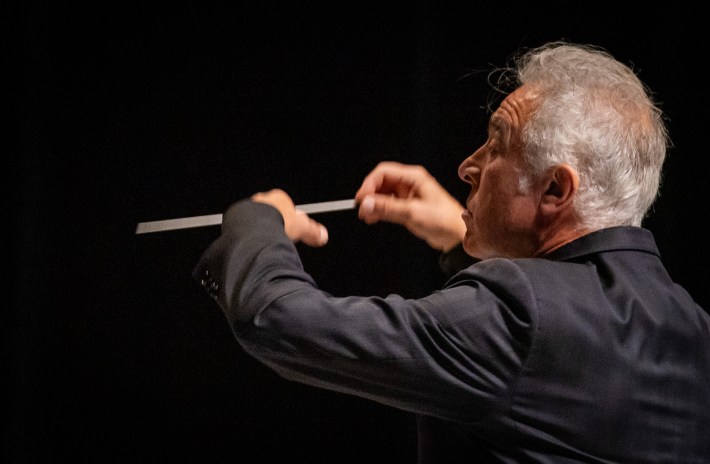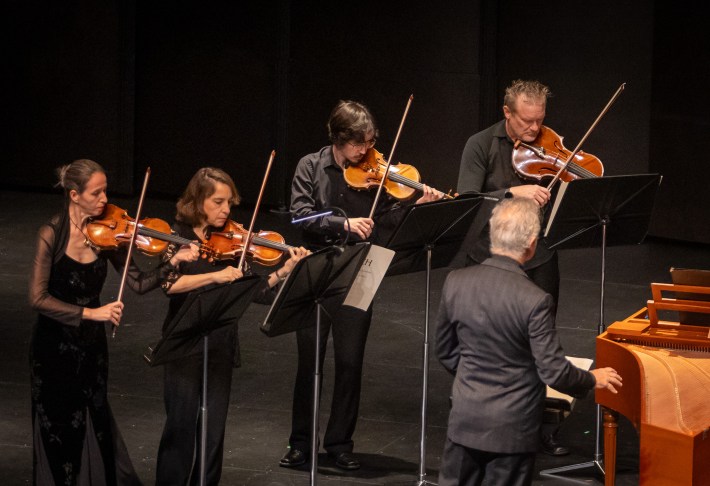Tulsa Symphony Orchestra: Bach, Fung, Tchaikovsky
Lorton Performance Center
September 14, 2025
TSO’s first concert of the year promised to be a banger. For something familiar, there would be Bach and Tchaikovsky, performed by the orchestra’s lush string section, and for something new, a violin concerto by Vivian Fung, which I was hopeful about because I knew the violin soloists would deliver.
The concert took place at TU’s Lorton Performance Center, which I love a lot more than the TPAC. The chairs are more comfortable, you have not one but two center aisles (why oh why does the TPAC have no center aisle? The fire marshal must have done math gymnastics real hard to get his exit plan approved), and the Lorton’s ceiling glows a dreamy sunset blue during the show, like you’re in a woodland bower. I was at peace just sitting there while the musicians warmed up.
The elegant guest conductor, David Lockington, introduced each of the three pieces. His commentary was informative, but he did a bit of surmising that this audience member could have done without. He said Bach’s Third Brandenburg Concerto had a lot of threes in it—three notes in a pattern, motives played three times, three different instruments playing the same tune, etc., which showed Bach’s genius. But frankly, saying a piece of classical music has a lot of threes is like saying a cake has a lot of sugar. Lasagna has a lot of noodles. A tree has a lot of leaves. You get the picture.
He went on to say (this is where I raised my eyebrows to what I’m sure was a level visible from the stage) that these threes represent the Holy Trinity, something Bach never said, wrote, or implied about this piece. Please, sir, if you can’t present evidence for your whimsical theories, stick to technical analysis.
All was forgiven when TSO began the Bach, featuring a pared-down chamber orchestra. A good dose of acoustic strings can truly soothe this savage beast. I forgot all about the Holy Trinity and bopped along with the repeated threes, letting the familiar melodies wash over me. The second movement, a harpsichord cadenza, was a pleasure. Harpsichordist Lyndon Meyer absolutely tore it up, playing an improvisational solo that went from tame to wild, scales ripping up and down, arpeggios swelling, all on the most delicate of keyboard instruments.

I settled in for Vivian Fung’s Concerto for Two Violins and String Orchestra, composed in 2018, as the full string orchestra filed onto the stage. Unfamiliar with Fung, a Canadian composer who is (hold onto your hat) still alive (I love the TSO’s programming of works by living, female, and non-white composers), I researched the piece before the concert. The recording did not impress me much, so I was skeptical, but the visual of seeing it played and the strength of the TSO soloists made me love it. The violin soloists, Ronnamarie Jensen and Jennifer Sherman, were stunning in their virtuosity and sensitivity, giving this contemporary piece classical gravitas. (They also looked fabulous in their sparkly gowns. Kudos, ladies.) Being a contemporary piece, it was full of changing rhythms and harmonic dissonances, but the plaintive melodies and back-and-forth between the soloists and the orchestra made it very listenable.
Fung’s concerto, both unfamiliar and contemporary, kept me on edge. But frankly, it felt good to be a little upset, like when you see your girlfriend and discuss horrific current events before talking about upcoming vacations and skincare and book club. And somehow, because you got upset in that safe space with your friend, you exorcized it from your system and could then get back to normal. That’s how the Fung felt: cathartic.

The Tchaikovsky was delightful. I didn’t even think about where I was, or who I was with (strangers, since mon ami Mr. Tulsa opted to stay home and watch the Chiefs; no judgment, we all love what we love). I was simply surrounded by semi-familiar melodies, since the Serenade for Strings pops up in movies and is performed pretty regularly. Nobody writes a waltz like Tchaikovsky. Please play that Elegy at my funeral.
I have one small bone to pick with the TSO. The orchestra shines when it plays full force, or when there is a solo, but when the texture is sparse, or the dynamic level is soft, or when an instrument section plays alone, the intonation can be a bit pitchy, or the accuracy can be a bit off. You know what you did, cellos. I’m telling you because I love you.
Lockington ended the concert with an encore, the Rigaudon from Grieg’s Holberg Suite. Concertmaster Rossitza Goza’s flawless technique was a standout in the violin solo sections, and the whole orchestra’s warm sound sent me home filled with anticipation for a wonderful season.
In these turbulent times, more and more evenings find me on the couch, eating soup, wearing pajamas and watching “Modern Family.” This concert, with two familiar, soothing pieces surrounding something new and challenging, was exactly what I needed. TSO’s 20th season is off to a great start.





